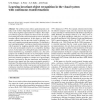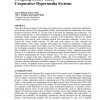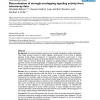52 search results - page 6 / 11 » Using Cooperative Artefacts as Basis for Activity Recognitio... |
CVPR
2010
IEEE
13 years 5 months ago
2010
IEEE
We consider the `group motion segmentation' problem and provide a solution for it. The group motion segmentation problem aims at analyzing motion trajectories of multiple obj...
BC
2006
13 years 7 months ago
2006
Abstract The cerebral cortex utilizes spatiotemporal continuity in the world to help build invariant representations. In vision, these might be representations of objects. The temp...
HT
1993
ACM
13 years 11 months ago
1993
ACM
This paper discusses issues for the design of a Dexter-based cooperative hypermedia architecture and a specific system, DeVise Hypermedia (DHM), developed from this architecture. ...
ACSAC
2002
IEEE
14 years 18 days ago
2002
IEEE
Active Spaces are physical spaces augmented with heterogeneous computing and communication devices along with supporting software infrastructure. This integration facilitates coll...
BMCBI
2006
13 years 7 months ago
2006
Background: As numerous diseases involve errors in signal transduction, modern therapeutics often target proteins involved in cellular signaling. Interpretation of the activity of...



